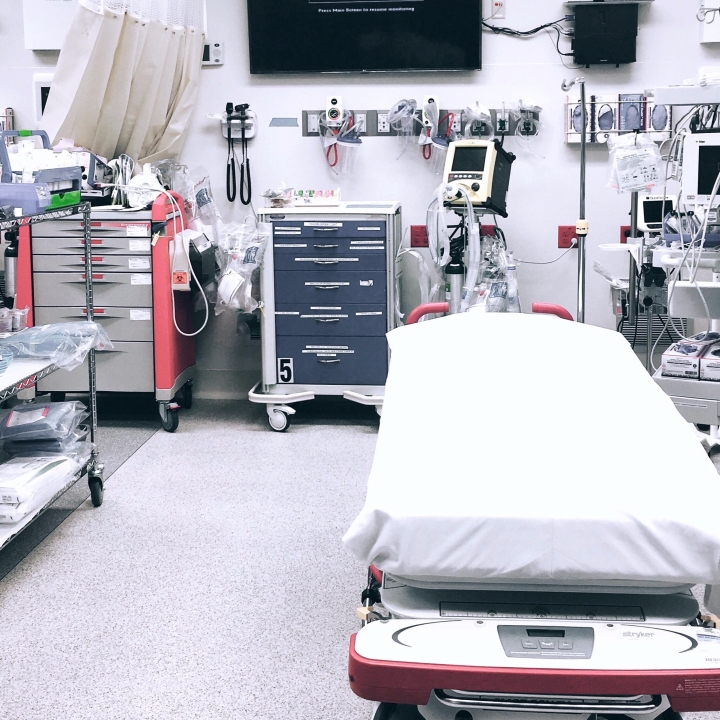
The Trauma Nursing Core Course (TNCC) can be a very daunting class to take as a new nurse. I was pretty much terrified when I was told I had to not only take the class but was only going to get a few weeks to study for it. They handed me this massive textbook and I was told to read the whole thing before class. I was completely overwhelmed. Luckily, I made it through the class with not too many new grey hairs and am here to share what I learned!
The primary survey is the initial assessment done by the trauma providers and trauma nurse to detect any life threatening injuries when a trauma patient enters the emergency department. The primary survey prioritizes the ABC’s and organizes the way way trauma patients are evaluated. This is the first chance one has to figure out what happened to the patient and to begin treatments.
A: Airway and Alertness: You are assessing the patients ability to protect their airway and the airways patency, all while maintaining spinal and cervical immobilization.
- Alertness Assessment
- This is assessed using AVPU, A (alert), V (alert to verbal stimuli), P (alert to pain), U (unresponsive to all stimuli)
- Airway Assessment
- Can the patient open and protect their airway
- Inspect the mouth for anything that could be obstructing the airway such as the tongue, teeth, foreign objects, blood, vomitus, secretions, edema, and burns
- Auscultate for obstructive airway sounds such as stridor
- Palpate for bony deformity that could be obstructing airway
- Assess the definitive airway if put in by EMS, make sure it has correct placement with no obstructions
- Treatment if airway is not patent
- Suction
- Remove debris
- Insert airway adjunct such as naropharyngeal airway
- Prepare to assist MD in inserting definitive airway such as an endotracheal tube
B: Breathing: You are assessing to see if the patient is breathing adequately and regularly.
- Breathing Assessment
- Inspect for spontaneous breathing, symmetrical rise and fall of chest, depth, pattern, rate of respiration, signs of respiratory difficulty, skin color (cyanotic or pale), wounds, contusions, abrasions, or deformities
- Auscultate for breath sounds and heart sounds
- Palpate bony structures of chest looking for any deformities, subcutaneous emphysema, or soft tissue injury (bruises or seat belt marks)
- Treatment if breathing is present
- Administer oxygen non-rebreather at 15 L
- Check breathing using end tidal CO2
- Treatment if breathing is absent
- Open the airway, jaw thrust with second person
- Insert airway adjunct
- Assist ventilation with bag mask device
- Prepare to assist MD in inserting definitive airway such as an endotracheal tube
C: Circulation and Control of Hemorrhage: You are assessing the patients ability to perfuse blood and assessing any uncontrolled bleeding.
- Circulation Assessment
- Palpate for presence of central and peripheral pulses, the rate and rhythm
- Check the skin color, temperature, and moisture
- Treatment if pulses are absent
- Initiate basic life saving CPR
- Assess for cause
- Hemorrhage Assessment
- Inspect for uncontrolled external/internal hemorrhage, skin color changes, bruising
- Treatment if there is uncontrolled hemorrhage
- Use pressure, elevate, tourniquets
- Initiate infusion of warmed isotonic crystalloid solution
- Prepare for possible blood administration and use of the rapid infuser
D: Disability: You are assessing the patients mental status.
- Assessment
- Inspect pupils: PERRL, Pupils that are equal, round and reactive to light
- Glasgow Coma Scale

- Treatment
- Obtain blood glucose and ABGs
- Prepare patient for a head CT
E: Exposure and Environmental control: You are exposing all of the patient, and warming the environment.
- Assessment
- Remove all clothing, cut off (preserve any clothing evidence)
- Reassess for any uncontrolled bleeding
- Note any obvious injuries that will need to be addressed
- Treatment
- Apply warm blankets to the patient
F: Full set of vitals and Family
- Vitals: obtain baseline (pulse, heart rate, oxygenation, blood pressure, temperature, respirations, weight, and pain), trend for changes
- Family: using an assign liaison, communicate with family the status of the patient and the plan of care, is the patient going to surgery, MedSurg/ICU, or being transferred
G: Get adjuncts: You are obtaining any tests that have not been completed yet and performing interventions that have not been completed yet
- Laboratory studies
- Monitoring for cardiac rhythm and rate, telemetry
- Insertion of naso or orogastric tube, and foley catheter if patient is intubated or if needed due to injury
- Apply supplemental oxygenation, monitor with end tidal CO2
- Pain assessment and treatment
I hope this primary survey breakdown is helpful for any emergency nurses studying for their trauma nursing certification and nurses/medical staff in general so that they are informed on all that goes into a trauma patient before the patient arrives to OR, or the floor!


Not being in the medical field, but being a mom who frequented an ER as my kids grew up, i still never knew most of these..
Thanks for the great information
LikeLike
You broke that down nicely Kirsten!! Thank you.
LikeLike